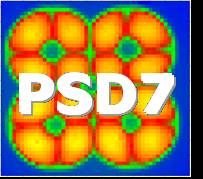Speaker
Dr
Deborah Herbert
(INFN Pisa)
Description
Positron Emission Tomography (PET) for small animal studies requires
high-resolution gamma cameras with high sensitivity. Traditionally,
inorganic scintillators are used and, in recent times, coupled to
position sensitive PMTs. Such PSPMTs are costly, operated at high
voltage and have a relatively low packing fraction. However, their
advantage, compared to current solid state photodetectors, is their
high signal-to-noise ratio.
The Silicon Photomultiplier (SiPM) is a silicon diode detector that
shows great promise as a photodetector for scintillators and hence
application in nuclear medicine imaging applications. The MRS
(Metal-Resistor-Semiconductor) structure of the SiPM leads to a self-
quenching, Geiger-mode avalanche photodiode (GAPD), that produces a
large gain (106) at low bias voltage (50V). The standard operation
of a GAPD is such that each signal produced in the depletion region,
regardless of the original number of photoelectrons, produces the
same fixed amplitude output signal, the magnitude of which is
determined by the quenching resistance. In this way a GAPD performs
as a digital counter, giving no information of the number of
original photoelectrons produced and thus prohibiting the
possibility of having analogue information for spectroscopy. The
SiPM structure overcomes this inherent limitation by dividing the
silicondiode surface area into a large number of regions called
microcells, each of which acts like an independent and identical
GAPD. This is achieved by forming the p-n junction in ~20 x 30 m2
cells, separated by a gap of a few microns, that defines the
detector structure. Thus, the avalanche region is localised to each
cell. If the outputs of all these microcells are summed together
then the output signal is proportional to the number of microcells
activated. In the MRS SiPM, the microcell signals are multiplexed by
the common metal electrode contact layer. In this way, the SiPM
provides a large, proportional signal for low to moderate photon flux
(Nphotons< Ncells), such that even a single optical photon can be
easily detected and resolved. The preliminary studies we have made of
the MRS SiPM have demonstrated a very promising photodetector that is
stable and rugged, has excellent single photoelectron resolution,
fast recovery time and a high gain at low bias voltage. Experimental
results demonstrating these performance characteristics will be
presented. The fabrication is fairly simple and does not require
special high-resistivity silicon, therefore having the potential to
be a low cost detector solution. There is no requirement for
special, low-noise electronics since the gain is sufficient to give
a large signal-to-noise ratio. Its dimensions are ideal for
forming high-resolution matrices for PET or other scintillator
imaging applications.
The disappointment with the original SiPM that was studied was that
the quantum efficiency was found to be very low. For this reason the
light yields measured with scintillation pixels was found to be
small, of the order of 25 photoelectrons for a 511 keV photopeak in
LSO. However, in the meantime, SiPM development has focused on the
improvement of the quantum efficiency to obtain better light yields.
In fact, with a blue sensitive version of this device we have
measured an energy resolution at 511 keV with a LSO pixel of 25%
which is approaching that measured with position sensitive PMTs.
Such a compact silicon detector, with a performance similar to a
PMT, is obviously well disposed to being developed into a close-
packed array in order to have a position-sensitive detector surface.
We propose a miniature, high-resolution detector head for a small-
animal PET imaging system that is based on such an array of SiPM. The
design is based upon the classic Anger camera principle; one
detector module layer consists of a continuous slab of scintillator,
viewed by a matrix of SiPM. A detector head of 5×5 cm2 in area is
proposed, constructed from three module layers of the continuous
detector described above. The stacked layers would give the system
intrinsic depth of interaction (DOI) information. Results of a
simulation, using the Monte Carlo package GEANT4 are presented.
The simulation results are used to determine the performance of a
single detector head and to optimize the geometry of the detector,
resulting in a high spatial resolution of up to ~0.6 mm full-width
at half maximum (FWHM) and a sensitivity determined by the number of
layers used.
Primary author
Dr
Deborah Herbert
(INFN Pisa)




